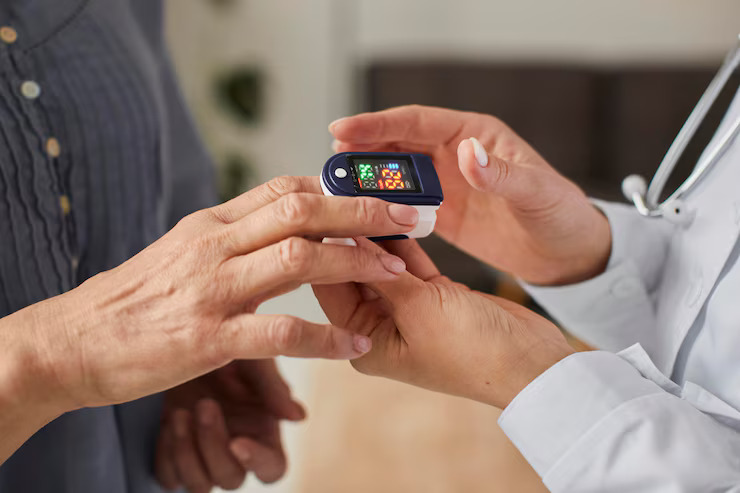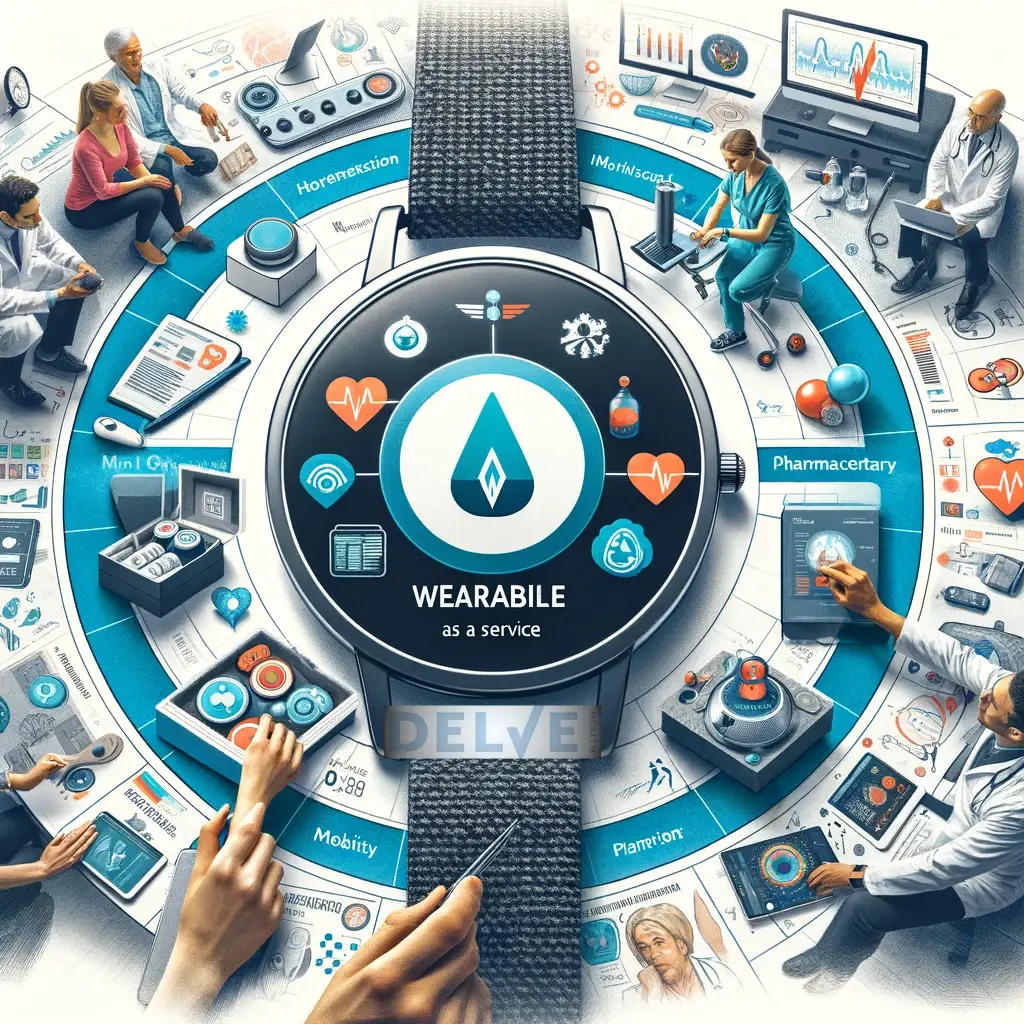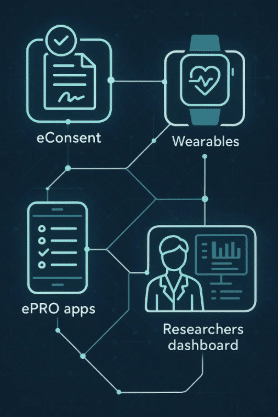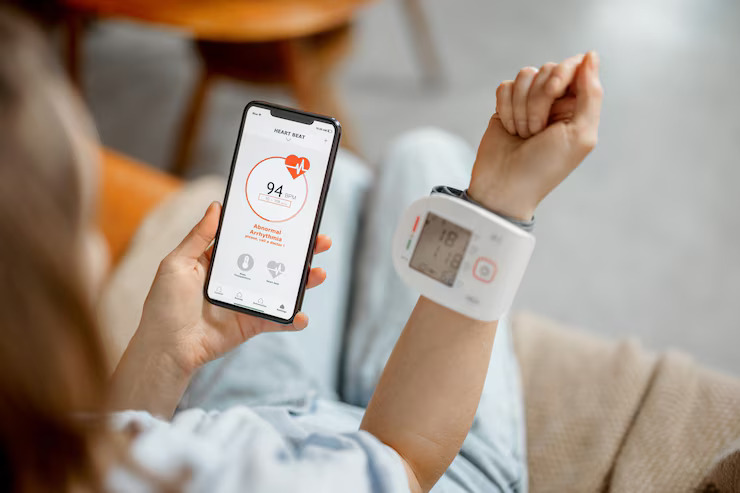In the era of digital health, wearable devices have revolutionized how we monitor our wellbeing. From tracking heart rates to monitoring sleep patterns, wearable technology has become an integral part of personal healthcare management. Despite their widespread use, an often-overlooked factor is the placement of these devices and how it affects the accuracy of collected data.
This article delves into the comparison of wearable placements – specifically the wrist, chest, and finger – and their impact on the accuracy of digital biomarkers.
Understanding Digital Biomarkers
Digital biomarkers are transforming how we understand and monitor health. These are quantifiable, physiological, and behavioral data points gathered through connected digital devices, especially wearables. From heart rate and sleep patterns to step count and oxygen saturation, these biomarkers offer a continuous and non-invasive method of assessing health metrics in real-time.
Unlike traditional health data collected during infrequent doctor visits, digital biomarkers provide a dynamic and holistic view of an individual’s well-being over time.
By harnessing these data points, healthcare providers and researchers can make more informed decisions, identify early signs of disease, and personalize treatment plans. However, the accuracy of these biomarkers is essential; poor-quality data can lead to misleading interpretations and flawed interventions.
That’s why the reliability of sensor technology and the proper calibration of wearable devices are critical. Ultimately, digital biomarkers pave the way for a more proactive, precise, and patient-centered approach to healthcare.
The Significance of Wearable Technology
Wearable technology has revolutionized healthcare by enabling continuous, personalized health monitoring. Devices such as the Apple Watch, Fitbit, and other smart bands empower individuals to track key health metrics with ease and convenience.
- Accessibility and Popularity: In the U.S., millions of people use wearables daily, reflecting a growing reliance on these devices to monitor and maintain their well-being.
- Real-Time Health Insights: Wearables allow for immediate feedback on activity levels, heart rate, stress, and sleep, promoting healthier lifestyle choices and early intervention.
- Enhanced Data Collection: These devices support the gathering of digital biomarkers in real-world settings, offering insights that traditional clinical visits cannot capture.
- Device Placement Matters: The effectiveness of wearable devices depends heavily on their correct placement. Misaligned or loosely worn sensors can result in inaccurate readings and poor data quality.
- Clinical Integration: The data from wearables can complement traditional healthcare records, aiding in diagnosis, treatment, and remote patient monitoring.
Wrist Wearables
Wrist-based wearables are the most widely adopted form of health-tracking devices globally. Their popularity stems from their convenience, sleek design, and ability to integrate easily into daily life without discomfort. Devices like smartwatches and fitness bands often include a wide array of sensors to track physical activity, heart rate, sleep quality, and even blood oxygen levels through optical technologies.
Key Features:
- Use of photoplethysmography (PPG) sensors to detect heart rate by analyzing blood flow through the skin.
- Built-in accelerometers and gyroscopes for activity and movement detection.
- Many include GPS and SpO₂ sensors to enhance tracking during exercise and rest.
Considerations:
- Accuracy can be compromised during high-intensity movements due to sensor shifts or sweat.
- Skin tone, tattoos, and the tightness of the band can affect signal quality.
- Best suited for general wellness tracking, less ideal for clinical precision.
Despite limitations in clinical accuracy, wrist wearables are excellent for everyday health monitoring. Their real-time insights and app integrations help users stay motivated and engaged in managing their wellness.
Chest Wearables
Chest-worn wearables are highly valued in both clinical and athletic settings for their superior accuracy in measuring heart rate and other cardiac signals. Unlike wrist devices, which rely on optical sensors, chest wearables often utilize electrocardiogram (ECG) sensors that detect the heart’s electrical activity directly, ensuring a higher fidelity of data.
Advantages:
- Positioned close to the heart, providing reliable heart rate measurements.
- Less prone to motion artifacts, especially during high-impact workouts.
- Often used in sports performance and medical diagnostics.
Limitations:
- May be less comfortable for prolonged or casual use.
- Typically require manual placement and adjustment, which may not suit all users.
- Fewer features compared to wrist wearables (e.g., sleep tracking may be limited).
Chest straps are ideal for short-term, high-accuracy monitoring, such as during training or diagnostics. However, their bulkier design and wearability limitations can impact user compliance over time. As a result, they are best used in targeted scenarios where data precision is a top priority.

Finger Wearables
Finger wearables, such as smart rings, are emerging as a highly accurate and user-friendly form of health monitoring. These devices use advanced optical sensors and leverage the anatomical advantages of the finger to capture high-quality PPG signals. The consistent pressure and thinner skin make the finger an optimal site for detecting physiological changes.
Strengths:
- Accurately measure heart rate, respiratory rate, blood oxygen saturation (SpO₂), and sleep cycles.
- Provide high signal clarity due to reduced interference from muscle movement compared to wrist or chest wearables.
- Extremely comfortable and lightweight, enabling 24/7 monitoring with minimal user discomfort.
Why They’re Growing in Popularity:
- Ideal for users seeking detailed insights without bulky hardware.
- Unobtrusive design fits naturally into daily routines.
- Suitable for both wellness tracking and early-stage clinical insights.
Finger wearables are becoming increasingly appealing due to their balance of comfort, precision, and continuous monitoring capabilities. They represent a powerful evolution in digital health tools, particularly for users who want accurate data without compromising on style or comfort.
Comparison of Accuracy by Device Placement
| Placement | Advantages | Disadvantages |
| Wrist | – Handy and broadly utilized – Simple for daily usage | – Susceptible to motion distortions – Precision affected by skin tone, tattoos, and fit |
| Chest | – Superior heartbeat accuracy – Perfect for exercise and medical applications | – Not so comfortable – Not optimal for wear throughout the day |
| Finger | – Exceptional precision – Comfortable and unobtrusive | – Not much long-term usage data – Few manufacturers on the market |
Impact of Sensor Technology on Accuracy
The type of sensor technology used in wearable devices plays a critical role in determining data accuracy.
- Wrist wearables primarily use optical sensors (like photoplethysmography or PPG) to measure heart rate and blood flow. While effective for general tracking, these sensors are sensitive to motion, skin pigmentation, body hair, and improper positioning—all of which can reduce data accuracy.
- Chest wearables often employ electrical sensors, such as electrocardiogram (ECG) technology, which measure the heart’s electrical signals directly. This method offers superior accuracy, particularly during intense physical activity, where other sensor types may struggle.
- Finger wearables combine advanced optical sensors with the naturally rich vascular environment of the finger. This allows for precise detection of heart rate, SpO₂, and sleep cycles, while also being comfortable enough for continuous wear.
Ultimately, sensor type and placement must work together to achieve reliable data. Choosing the right device depends on the use case—whether it’s casual wellness tracking, clinical-grade monitoring, or athletic performance.
Market Trends and Consumer Preferences
The wearable technology market continues to evolve as consumers prioritize convenience, accuracy, and style. Wrist wearables remain the most popular choice due to their versatility, aesthetic integration into fashion, and ease of daily use. Their ability to offer features like notifications, fitness tracking, and basic health monitoring keeps them at the forefront of consumer demand.
However, as health awareness deepens, more users are seeking precision-oriented wearables. This shift is driving interest in chest and finger wearables, which provide enhanced data accuracy—especially for heart rate, sleep analysis, and oxygen saturation. The future of wearables lies in balancing everyday usability with clinically relevant insights.

Challenges in Wearable Technology
Despite their growing popularity, wearable devices face several challenges that impact their adoption, accuracy, and trustworthiness.
1. Accuracy vs. Comfort
- Devices like chest wearables offer clinical-grade data but can be uncomfortable for long-term use.
- Wrist wearables are easy to wear daily but can produce less reliable data during intense activity.
2. User Engagement and Adherence
- A device’s long-term value depends on user adherence.
- If a wearable is cumbersome or intrusive, users may abandon it regardless of its data quality.
3. Data Privacy and Security
- Wearables collect deeply personal health data.
- Ensuring secure data storage, encrypted transmissions, and transparent privacy policies is essential.
- Regulatory compliance with standards like HIPAA or GDPR adds layers of complexity.
4. Battery Life and Connectivity
- Continuous monitoring drains battery life, impacting usability.
- Connectivity issues between devices and apps can result in data loss or delays.
As wearables become more integrated into healthcare, overcoming these challenges will be critical to gaining user trust and meeting clinical standards.
The Future of Wearable Devices
Wearable devices are rapidly evolving, driven by breakthroughs in AI, sensor technology, and miniaturization. These advancements will improve both the accuracy and comfort of wearables, making them more suitable for continuous, real-world health monitoring.
Future devices will offer smarter data analysis, enabling early detection of health issues and more personalized insights. As interconnectivity improves, wearables will seamlessly integrate with smartphones, smart home devices, and healthcare systems, forming a connected health ecosystem.
This shift positions wearables not just as fitness tools, but as essential health companions supporting proactive and preventive care.
Conclusion: The Importance of Wearable Placement
Wearable placement plays a vital role in the accuracy of digital biomarkers. While wrist wearables offer ease of use, they may falter during intense activity. Chest wearables provide precise data but can be uncomfortable for daily wear, whereas finger wearables combine accuracy with comfort, though they are relatively new to the market. As sensor technology and user expectations evolve, a hybrid approach that blends precision with usability is likely to emerge.
To see how these advancements are being applied in real-world decentralized health solutions, explore Delve Health and discover the future of connected care.
FAQs
Why does the placement of a wearable device affect its accuracy?
The accuracy of wearable devices is influenced by placement due to their reliance on different sensor technologies. For instance, wrist wearables typically use optical sensors which can be disrupted by motion. Chest devices, closer to the heart, capture electrical signals, offering better accuracy for heart rate monitoring. Finger devices also utilize advanced optical sensors, benefiting from the finger’s vascular properties for precise readings. The effectiveness of these sensors can vary based on where they’re placed on the body, which directly impacts the quality of the data collected.
Which type of wearable is best for athletes?
Athletes often require highly accurate data for effective training and performance assessment. Chest wearables are generally favored among athletes because of their precision in capturing heart rates and other physiological metrics. The placement near the heart and use of electrical sensors make chest wearables well-suited for high-intensity tracking. However, wrist wearables are quickly advancing and now offer features that cater to athletes, balancing convenience and data quality. The choice ultimately depends on the athlete’s specific needs and preferences for comfort versus accuracy.
Are wearable devices reliable for medical diagnostics?
Wearable devices have significantly advanced and are increasingly used for health monitoring, but they should not be solely relied upon for medical diagnostics. They offer valuable insights and early detection potential for health issues, prompting further medical evaluation. Of the different types, chest wearables are often deemed the most reliable due to their accuracy. Nevertheless, all wearables can be affected by factors such as user adherence, placement, and technical limitations. As technology progresses, the reliability of these devices in clinical settings continues to improve.
How do finger wearables compare to others in terms of user comfort?
Finger wearables are generally praised for their user comfort and discreet presence. Unlike chest wearables, which can feel intrusive and less comfortable for daily wear, or wrist wearables, which can be impacted by other activities (e.g., typing), finger wearables are lightweight and unobtrusive. They sit comfortably on the finger like a regular ring, minimizing interference with daily activities. Coupled with their precision, finger wearables are becoming increasingly popular among consumers who seek a balance between comfort and functionality.
What future developments can we expect in wearable technology?
The future of wearable technology is geared towards enhancing both accuracy and user integration. Innovations may include AI-driven data analysis for improved precision and predictive insights, lighter and more durable materials for greater comfort and wearability, and deepening integration with other smart devices for a cohesive health monitoring ecosystem. We can anticipate advancements in battery life, data privacy features, and the ability to monitor new health metrics. The goal is to create wearables that are not only more accurate but also seamlessly fit into everyday life, enhancing overall wellbeing through technology.













